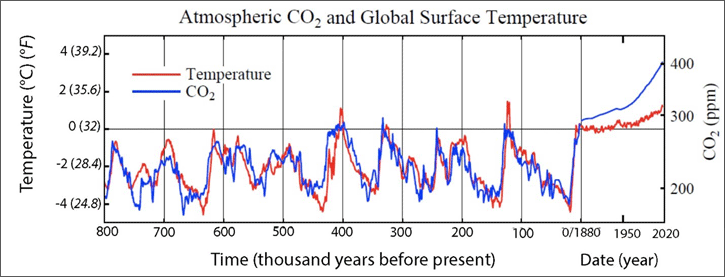CLEARING UP CO2 MISUNDERSTANDINGS (page 65 in Moving to Higher Ground, © John Englander, 2021)
As discussed in Chapter 4 , the science behind the “greenhouse effect”, and the correlation between temperature and CO2 (carbon dioxide) has been understood for almost two centuries. Over the long term of decades and centuries, global CO2 and temperature move in close synchronization.
- As temperature increases, the oceans warm and release gases into the atmosphere, including CO2.
- As CO2 levels increase in the atmosphere, it functions like the clear roof of a greenhouse, trapping heat and warming the planet.
Either can lead, or be the driver; the other will follow. In the current era, the current rapid increase in CO2 is driving up the global “thermostat” or heat level.
In 1958, a scientist at Scripps Institution of Oceanography, the late Charles David Keeling, perfected a very precise way to measure CO2 levels. He set up an isolated research laboratory on Mauna Loa, a Hawaiian mountaintop and began recording daily CO2 levels. That research continues to this day, as illustrated in Figure 12. The “Keeling Curve” shows a clear upward trend, along with a very consistent saw-tooth temperature pattern that correlates with the seasonal variation expected with the annual vegetation cycles. Plants in the Northern Hemisphere, which contains most of the Earth’s land mass and vegetation, photosynthesize in the spring and summer months, removing CO2 from the atmosphere. This accounts for the annual decrease in CO2 concentrations observed in the curve. When Keeling began his measurements, the level of CO2 in the atmosphere was 313 parts per million (ppm).

Graph showing the steady increease of global CO2 correlating with burning fossil fuels. (Data: R.F. Keeling, S.J. Walker, S.C. Piper, and A. F. Bollenbacher.... Cripps CO2 Program, Scripps Institute
As Moving to Higher Ground is published in 2021, global CO2 is at 419 ppm, a 32 percent increase in just 60 years. The increase in CO2 levels correlates with the burning of fossil fuels and industrialization, just as one would expect.
- For the latest measurements from Mauna Loa and more graphics about CO2, visit: https://esrl.noaa.gov/gmd/ccgg/trends/mlo.html
Some of those who dismiss the issue of higher carbon dioxide levels say things like, “It’s natural... and will help plants grow better.” While there is some truth in the statement that more CO2 will increase plant productivity, there are upper limits to the benefit of this effect. The fact that more of something can be positive to a degree, does not mean it is benign or harmless. As an analogy, water is essential to life, but drink too much and you can die. Even life-sustaining oxygen will become toxic at a pressure above two atmospheres, putting the brain into convulsion. The point is that CO2 is not harmless. It is an extremely powerful substance for humans, for animals, for plants and for the atmosphere. Furthermore, other factors are already damaging and destroying forests and plants, such as intense logging and farming practices, high heat, drought and deluge rain.
While CO2 and temperature increase and decrease in close coordination over thousands of years, there is a delay in their synchronization. That is, an increase in CO2 level will take decades to show up as warmer temperature. Warming temperature takes decades to release CO2 from the oceans measurably increasing global levels.
Figure 13 illustrates the close correlation of CO2 and global average temperature over the last 800,000 years. You can see that, at times, CO2 increases precedes temperature increases and vice versa. The right side of the graph expands the timescale of the last century, where temperature increase since 1880 has lagged behind the increase in CO2 level.

Figure 13: This chart shows the correlation between temperature and CO2 over the last 800,000 years. The timescale for the last century has been expanded. Paleo global surface temperature change is from ocean core data of Zachos et al. (Nature 451, 279-283, 2008) via equations of Hansen et al. (Phil. Trans. Roy. Soc. A, 371, 20120294, 2013)
It can take decades for even the surface layer of the ocean—the top 600-700 feet (200 meters)—to fully adjust to a single degree of warmer air temperatures. Pioneering oceanographer, the late Dr. Wallace Broecker estimated that it could take as long as a thousand years for the entire ocean to equalize to a new average global air temperature[1]. This is one of the reasons that sea level is projected to rise for centuries after the atmospheric temperature stabilizes again.
[1] Robert Kunzig & Wallace S. Broecker, “Fixing climate: the story of climate science - and how to stop global warming”, (Great Britain: Green Profile, 2009).